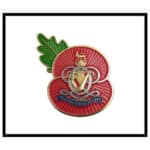Enlisting into the 8th King’s Royal Irish Hussars in 1926, Tom would have required a vivid imagination to foresee the events which were to take place during his twenty-seven years with the colours.
He was first and foremost a cavalryman of the highest qualification, having obtained the much-coveted Distinguished Grade on the 1931 Cavalry course at Weedon.
Rejoining the Regiment at Aldershot, he became a valued member of the riding school staff, remaining there instructing the rides and schooling the ponies with great success until 1935, when the Regiment mechanised and the school disbanded.
Tom then returned to duty, having quickly climbed the promotion ladder as the following shows: Lance Corporal 1928: Corporal 1930: Local Sergeant 1931: Sergeant 1932: Warrant Officer 2 1934 and Warrant Officer 1 1940. By any standard, this was rapid but by pre-war standards it was meteoric.
As Regimental Sergeant Major he served in Palestine and in Africa, played his full part in the desert campaign until 1941 when he was taken prisoner near Tobruk.
Needless to say his conduct as a Prisoner of War was exemplary. maintaining morale and discipline and commanding part of the camp at Fallingbostel.
As he used to relate, it was a source of great joy and pride to him when in 1945 the 8th Hussars overran the area and liberated the camp, that he was able at one and directly to report back from regimental duty.
After a short break he resumed as RSM and was a great success, having a ferocious pride in his Regiment and in particular in the Sergeants’ Mess, and being a firm but fair disciplinarian whose own turnout was always beyond reproach.
He left for civilian life in 1951, having been Mentioned in Dispatches and also receiving the Commander in Chief’s Certificate.
It is pleasing to record that he then spent many happy years running the Stud for the late Colonel Pat de Clermont in Northumberland.



